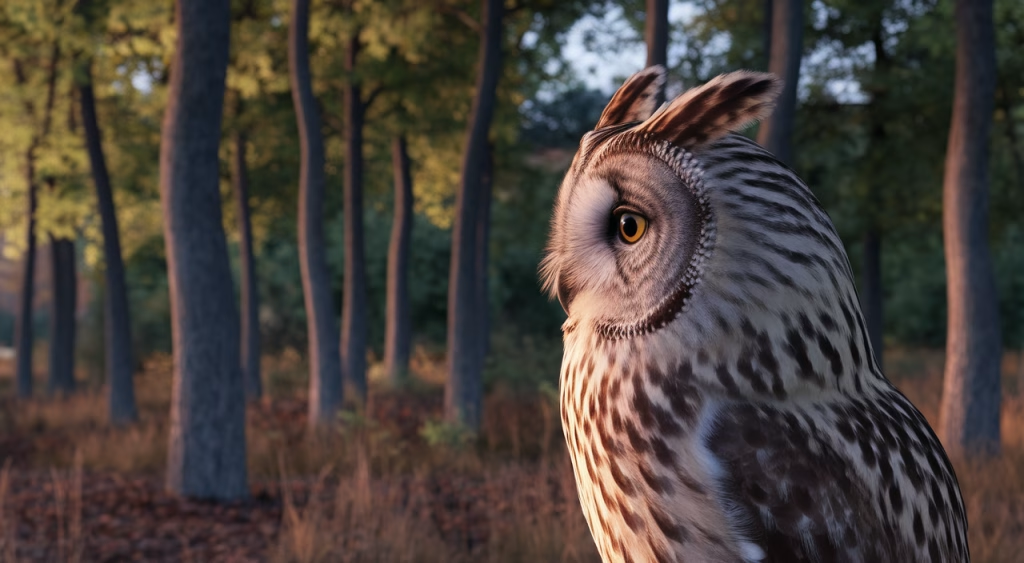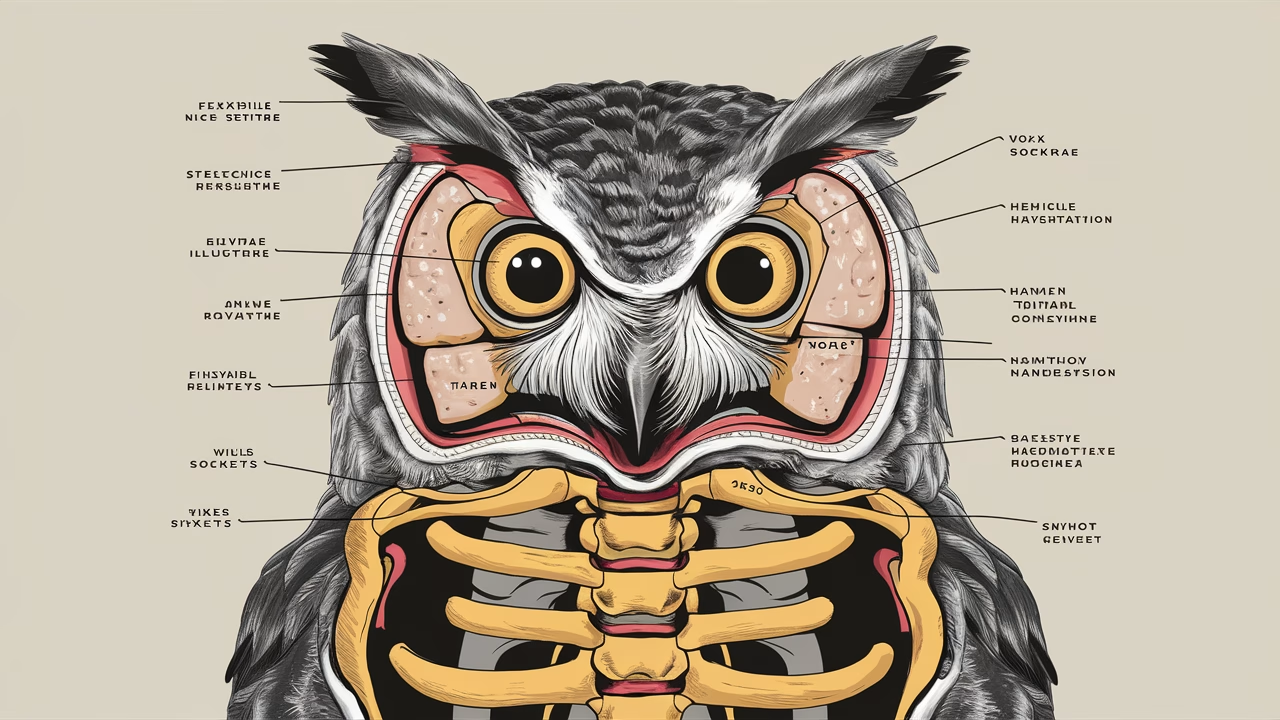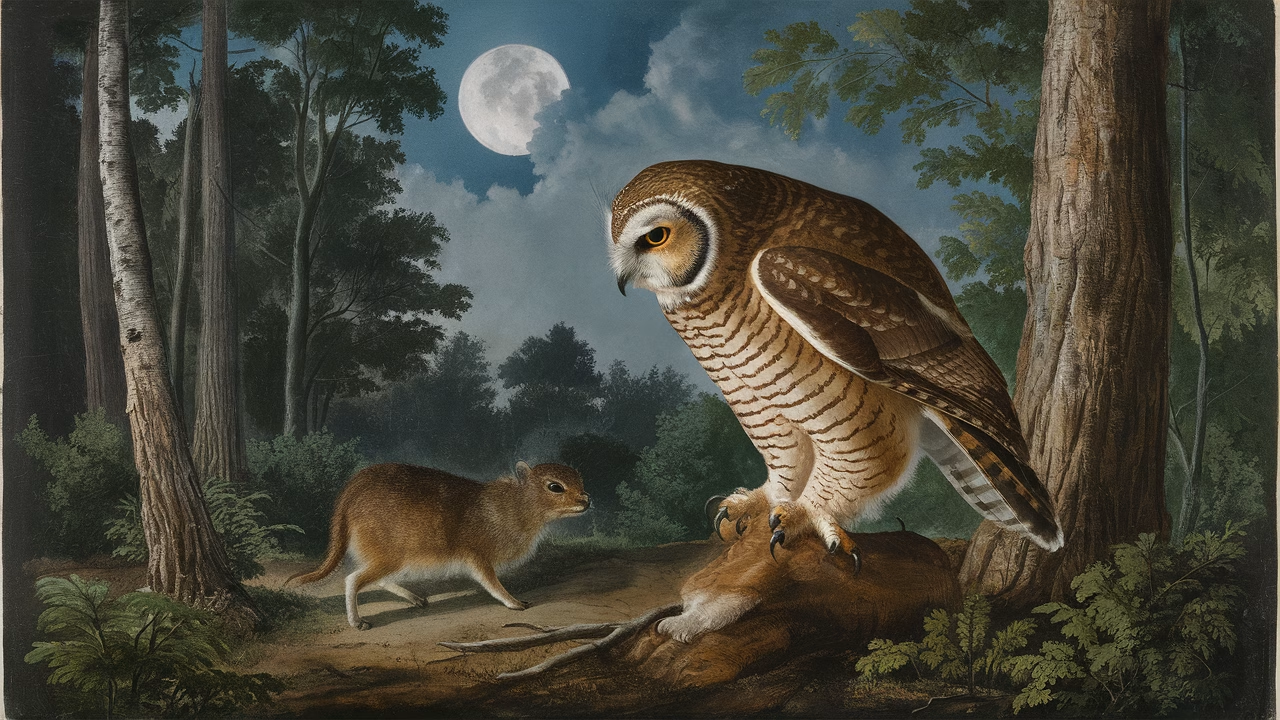Why can’t owls move their eyes?
Owls can’t move their eyes because their eyeballs are structurally different from ours. Instead of spherical eyeballs, owls have elongated, tube-shaped eyes that sit firmly inside tight bony sockets in their skulls—known as sclerotic rings. This unique owl eye socket design grants them superior depth perception and light sensitivity, critical for night hunting. But it comes with a significant trade-off: no eyeball movement whatsoever.
TL;DR: The Science Behind Owls Rotating Their Heads
- Fixed Eyes: Owl eye sockets hold elongated eyes in place, eliminating movement.
- Head Rotation: To compensate, owls rotate their heads up to 270 degrees using 14 flexible neck vertebrae.
- Circulatory Adaptations: Owls have specialized arteries and reservoirs that maintain blood flow during extreme rotation.
- Survival Advantage: This head-turning ability enhances prey detection in owls and helps with predator avoidance.
- Evolutionary Marvel: These features evolved to support their role as apex nocturnal hunters.
Anatomy of Owl Eyes and Neck
Understanding an Owl’s Fixed Gaze
Imagine watching a movie in a theatre but never being able to glance side to side—you’d have to turn your whole seat for every new scene. That’s exactly what life is like for an owl. Their eyes are completely locked into place within their skull, immobile but incredibly large relative to body size. In some species, these massive eyes nearly touch at the back of the skull.
The remarkable consistency of owl eyesight relies on this structural feature known as the owl eye socket. These rigid, tube-shaped sockets protect the delicate eye structures specifically designed for low-light environments. While restricting all motion, this unique shape dramatically enhances focus and night vision capabilities.
An Incredible Neck Made for Swiveling
To offset their visual rigidity, owls have evolved remarkably long, flexible necks with 14 cervical vertebrae—exactly double the number humans possess. This surplus gives them exceptional range in owl head movement. Contrary to popular myth, they don’t spin their heads completely around. However, they can rotate them an astonishing 270 degrees in either direction—almost three-quarters of a full circle.
Owls also possess specialized adaptations in their vertebral arteries that allow blood to continue reaching the brain even when major vessels become constricted during extreme twists. Some owl species even have blood reservoirs that collect and store blood before rotation, which they draw upon mid-spin to maintain circulation.
Adaptations for Survival
Evolution of Owl Eye Sockets and Neck Flexibility
Over millions of years, the evolution of owl eye sockets has consistently prioritized sharper, more accurate night vision capabilities. This evolutionary pressure meant elongating the eyes and developing those distinctive tube-like sockets. Naturally, owls had to counterbalance this restriction with the simultaneous development of advanced neck mobility.
Here’s what this crucial survival trade-off looks like:
| Feature | Benefit | Consequence |
|---|---|---|
| Fixed Eye Sockets | Sharp, stable vision for nocturnal prey | No lateral eye movement |
| 14 Vertebrae Neck | Head rotation up to 270 degrees | Requires specialized blood vessel adaptations |
| Enlarged Eyes | Extended night vision and light capture | High skull volume and immobility |
Why Can’t Owls Move Their Eyes? The Physics Behind It
This question deserves a detailed scientific breakdown. The primary reason lies in the complete absence of extraocular muscles needed for horizontal or vertical eyeball motion. Think of their eyes as high-powered camera lenses permanently mounted to a tripod. You simply cannot adjust the lens direction unless you rotate the entire camera apparatus.
But what does this anatomical reality mean in practical terms? It keeps their vision extremely stable and focused, especially useful when tracking fast-moving prey under dim moonlight conditions.
How Owls Detect Prey
Head Rotation as a Hunter’s Tool
Everything about owl behavior demonstrates their predatory mastery. While we’ve explored their eyes and neck anatomy, what’s truly extraordinary is how owls initially assess their surroundings without moving their heads at all. They’re absolute masters of minimal movement—this stealth approach helps them remain completely undetected by potential prey.
When an owl hears or senses prey nearby, it doesn’t make sudden movements—instead, it slowly rotates its head inch by inch, methodically locking onto the target. Unlike other forward-facing predators that scan with quick eye bursts, owls rotate like a biological radar dish until they precisely locate their mark. This quiet, deliberate process significantly enhances prey detection in owls while minimizing any motion that could reveal their position.
Binaural Hearing + Neck Rotation = Bullseye Accuracy
Owls don’t rely solely on their exceptional vision. Their asymmetric ear placement allows them to detect sound direction both horizontally and vertically with remarkable precision. When you combine this acoustic ability with their 270 degrees of head rotation, they create a complete sensory field around themselves—all without taking flight or changing position.
Conclusion: The Fascinating World of Owls
When you observe owls in their natural habitat, it’s impossible not to marvel at their silent, powerful head rotations. But now we understand it’s far more than impressive theatrics—it’s precisely engineered survival architecture. From specialized owl eye sockets to remarkable owl head movement capabilities, evolution has sculpted these birds with fixed eyes and mobile heads to absolute perfection.
Whether perched motionless on a tree limb or diving silently toward unsuspecting prey, owls utilize their entire head and neck like a sophisticated biological turret. Understanding these remarkable adaptations allows us to appreciate not just their exceptional hunting prowess, but the intricate interplay of form and function that defines nature’s most successful predators.
Frequently Asked Questions
- Can all owls rotate their heads 270 degrees?
- All owl species can rotate their heads impressively, though the full 270-degree capability varies slightly between species.
- Why do owls need to rotate their heads instead of their eyes?
- Because their eyes are fixed inside rigid sockets, they must rotate their heads to change their field of vision.
- Do owls get dizzy from rotating their heads so far?
- No, owls have evolved to manage such motion without vertigo or blood flow interruption.
- Is an owl’s vision better than a human’s?
- Yes, especially in low-light conditions. Their eyes are adapted for superior night vision with more light-sensitive rod cells.
- How do owls avoid predators if they can’t see behind them?
- Their wide rotation combined with acute hearing ensures 360-degree awareness to detect threats.
- What happens if an owl breaks a vertebra in its neck?
- Neck injuries can severely impair an owl’s survival, as it relies heavily on mobility for vision and hunting.
- Do any other animals have similar head rotation abilities?
- Some reptiles and birds show limited ability, but owls are unmatched in both range and flexibility.





